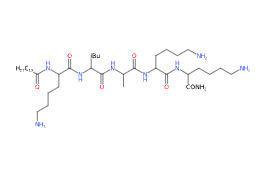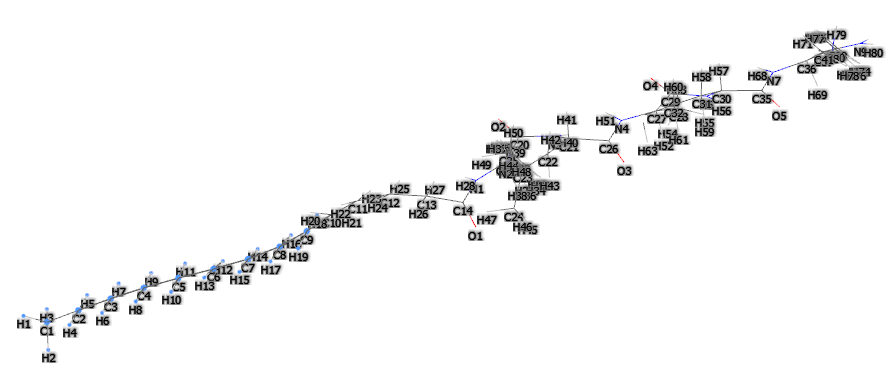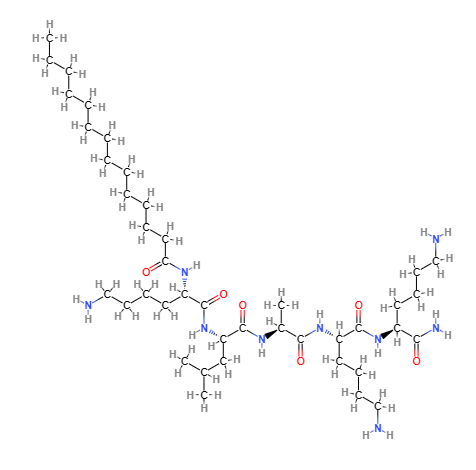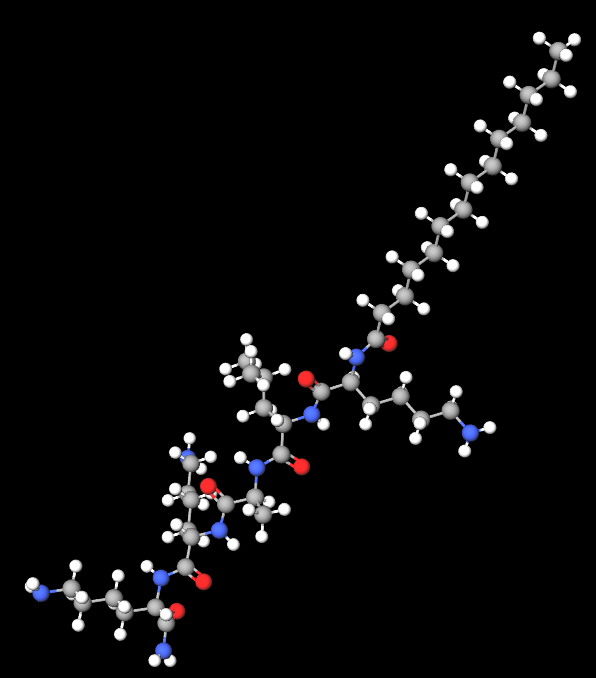Myristoyl pentapeptide-17 is a rather small chemical compound, protein 5-peptide, which belongs to the class of peptides (proteins), a synthetic peptide used in cosmetics and skincare products.
The name describes the structure of the molecule:
- Myristoyl refers to myristic acid, a type of fatty acid. In this context, it indicates that the peptide chain is attached to a myristic acid molecule. Myristoylation is a form of lipid modification that can affect the biological activity and solubility of peptides.
- Pentapeptide-17 indicates that the compound is a peptide consisting of five amino acids (pentapeptide). The number 17 is a specific designation for this particular sequence of amino acids. Peptides are short chains of amino acids that are the building blocks of proteins. In skincare, they are known for their ability to communicate with and direct skin cells to behave in certain beneficial ways, such as stimulating collagen production or repairing skin.
Description of Raw Materials and Their Functions
Myristic acid. A saturated fatty acid used as the lipophilic component in myristoyl pentapeptide-17. It provides the hydrophobic part of the peptide, enhancing its affinity for lipid structures.
Pentapeptide-17. A short chain of five amino acids that forms the peptide structure of the compound. These peptides are known for their bioactive properties, including stimulating hair and eyelash growth.
Reagents for Peptide Synthesis. Used to bond the amino acids and form the pentapeptide, and subsequently to attach the myristic group to the peptide.
Industrial Chemical Synthesis of Myristoyl Pentapeptide-17
- Preparation. The synthesis begins with the formation of pentapeptide-17 through peptide synthesis, which involves the sequential bonding of amino acids.
- Myristoylation. After the peptide is formed, the myristic group is attached to the peptide chain, forming myristoyl pentapeptide-17.
- Reaction Control. The reaction is monitored to ensure that the myristoylation occurs correctly and that the final product has the desired properties.
- Purification. After synthesis, the product is purified to remove impurities and by-products.
- Quality Control and Packaging. Myristoyl pentapeptide-17 undergoes quality checks and is then packaged for use in cosmetic products, particularly those aimed at hair and eyelash care.
It appears in the form of a white, water-soluble powder.
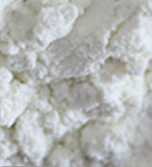
What it is used for and where
Myristoyl Pentapeptide-17 is often used in cosmetic formulations for its potential benefits in enhancing the appearance of skin and hair. It is particularly noted for its use in eyelash-enhancing products, where it is believed to help improve the length and thickness of eyelashes.
Cosmetics
Skin conditioning agent. It is the mainstay of topical skin treatment as it has the function of restoring, increasing or improving skin tolerance to external factors, including melanocyte tolerance. The most important function of the conditioning agent is to prevent skin dehydration, but the subject is rather complex and involves emollients and humectants that can be added in the formulation.
It directly activates the keratin gene and contributes to eyelash growth and hair growth at the hair follicle by aiding scalp microcirculation. It reduces follicle ageing and follicle atrophy caused by dihydrotestosterone.
It is included in formulations of anti-ageing products.
Use: 0,01% -0,03%
For more information: Myristoyl pentapeptide-17 studies
| Appearance | White powder |
| pH | 4-6 |
Boiling Point
| 1071.6±65.0°C at 760 mmHg |
Flash Point
| 601.9±34.3 °C |
| Density | 1.1±0.1 g/cm3 |
| PSA | 266.65000 |
Vapor Pressure
| 0.0±0.3 mmHg at 25°C |
| Refraction Index | 1.510 |
| LogP | 3.89 |
| Storage | -20°C |
- Molecular Formula C41H81N9O6
- Molecular Weight 796.1
- Exact Mass 795.630981
- CAS 959610-30-1
- UNII
- EC Number
- DSSTox Substance ID
- IUPAC N-[(2S)-6-amino-1-[[(2S)-1-[[(2S)-1-[[(2S)-6-amino-1-[[(2S)-1,6-diamino-1-oxohexan-2-yl]amino]-1-oxohexan-2-yl]amino]-1-oxopropan-2-yl]amino]-4-methyl-1-oxopentan-2-yl]amino]-1-oxohexan-2-yl]tetradecanamide
- InChI=1S/C41H81N9O6/c1-5-6-7-8-9-10-11-12-13-14-15-25-36(51)47-33(23-17-20-27-43)39(54)50-35(29-30(2)3)41(56)46-31(4)38(53)49-34(24-18-21-28-44)40(55)48-32(37(45)52)22-16-19-26-42/h30-35H,5-29,42-44H2,1-4H3,(H2,45,52)(H,46,56)(H,47,51)(H,48,55)(H,49,53)(H,50,54)/t31-,32-,33-,34-,35-/m0/s1
- InChl Key NFPWMUOQSJXGGZ-ZZTWKDBPSA-N
- SMILES CCCCCCCCCCCCCC(=O)NC(CCCCN)C(=O)NC(CC(C)C)C(=O)NC(C)C(=O)NC(CCCCN)C(=O)NC(CCCCN)C(=O)N
- MDL number
- PubChem Substance ID
Synonyms
- N-((5S,8S,11S,14S,17S)-1,21-diamino-8-(4-aminobutyl)-5-carbamoyl-14-isobutyl-11-methyl-7,10,13,16-tetraoxo-6,9,12,15-tetraazahenicosan-17-yl)tetradecanamide
- Myr-Lys-Leu-Ala-Lys-Lys-NH2
- N-Tetradecanoyl-L-lysyl-L-leucyl-L-alanyl-L-lysyl-L-lysinamide
- L-Lysinamide, N-(1-oxotetradecyl)-L-lysyl-L-leucyl-L-alanyl-L-lysyl-
- N2-(1-Oxotetradecyl)-L-lysyl-L-leucyl-L-alanyl-L-lysyl-L-lysinamide
References_______________________________________________________________________________________
(1) Sachdev, M., Velugotla, K., Revanker, S., & Somasekhar, G. (2020). An open-label, single-center, safety and efficacy study of eyelash polygrowth factor serum. The Journal of clinical and aesthetic dermatology, 13(2), 61.
Abstract. Objective: We sought to evaluate the efficacy of a polygrowth factor serum for increasing length, luster, thickness, and volume of eyelashes in a group of healthy Indian women. Design: This was a 90-day, open-label, single-center safety and efficacy study. Thirty Indian female participants, aged 15 to 45 years old, were enrolled in the study; 29 of these subjects completed the study. There were four assessment visits: at baseline (Day 0) and on Days 30, 60, and 90. Subjects were instructed on the application of the test product uniformly to both eyes on the upper and lower eyelid margins. Subjects applied the product once nightly for 90 days. Measurements: At each visit, subjects underwent ophthalmological and dermatological assessments and digital image photographs using Visia CR imaging system. Improvement in eyelash length, density/volume, luster, and curl were evaluated using imaging and software technologies. Results: Improvement in test parameters was observed 30 days after initiation of product usage. Among the 29 subjects who completed the study, improvements in length (10.52%), volume (9.3%), luster (11.43%), thickness (35%), and curl (50.83%), compared to baseline, were recorded. Conclusion: The study demonstrated efficacy in improving eyelash length, luster, thickness, and curl. The results were observed as early as 30 days of product usage and persisted until the last visit following 90 days of product usage. There were no adverse events associated with the product. We concluded that the polygrowth factor serum was well tolerated and effectively improved eye lash length, luster, thickness, and volume in our patient sample. Additional randomized, controlled studies with larger samples are needed to confirm our findings.
(2) Alsalhi, W., Alalola, A., Randolph, M., Gwillim, E., & Tosti, A. (2020). Novel drug delivery approaches for the management of hair loss. Expert opinion on drug delivery, 17(3), 287-295.
Abstract. Introduction. Alopecia is a common clinical complaint for patients and often a source of significant psychological distress. The goal of therapy is to stop hair loss and encourage regrowth. Many treatment modalities are available and novel drug delivery approaches are needed to maximize results and minimize potential side effects. Areas covered Many novel drug delivery approaches for the management of hair loss have been developed in recent years. This review summarizes all therapeutic modalities used to enhance drug penetration into the scalp including microneedling, laser-assisted, radio-frequency, sonophoresis, iontophoresis. Advantages and developments in nanoparticles drug delivery approaches are also discussed. Expert opinion. When considering novel drug delivery approaches for alopecia, physicians should consider the intended target and etiology of hair loss....… myristoyl pentapeptide-17, adenosine, piroctone olamine, retinol, and caffeine, significantly reduced hair shedding, and increase the hair mass and density at 3 and 6 month...
![]() Myristoyl pentapeptide-17
Myristoyl pentapeptide-17 



